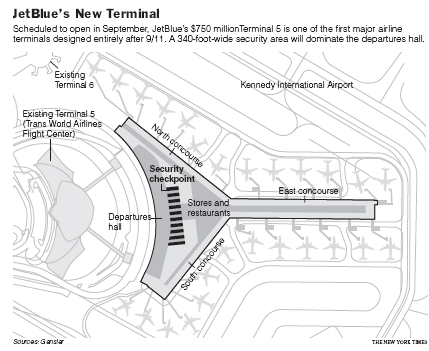March 11th, 2008 — 12:00am
The design of JetBlue’s new terminal at JFK as reported in the NY Times is a good example of the intersection of user experience design, and the specific technical and political requirements of the post-9/11 security-oriented state. The layout of the new terminal is focused on directing passengers as quickly as possible through a screen of 20 security lanes, and includes thoughtful features like wide security gates to accommodate luggage and wheelchairs, and rubber flooring for areas where people end up barefoot.
I’m of two minds about designing experiences and architectures specifically to enable security purposes. Anything that improves the currently miserable experience of passing through security screenings is good. (I am waiting for reports on people who show up at the gate wearing only a speedo one of these days, just to make a point.)

But in the long run, do we really want experience design to help us become culturally accustomed to a security-dominated mindset? Especially to the point where we encode this view of the world into our infrastructure? Lurking not so quietly below the surface of the design of the new JetBlue terminal is Bentham’s Panopticon (full contents here). The new terminal’s floor plan is a classic funnel shape, disturbingly similar in concept to the abattoir / apartment block described in the famous Monty Python Architect Sketch.
Pace layering makes clear that architectures change slowly once in place. And authorities rarely cede surveillance capabilities, even after their utility and relevance expire. Should experience design make an architecture dedicated to surveillance tolerable, or even comfortable?
Comment » | Architecture, Ethics & Design, User Experience (UX)
June 22nd, 2004 — 12:00am
Five minutes after logging into my shiny new gmail account today and sending out a hello message toa few friends, I got a taste of new technology pranksterism: an old friend sent a reply to my hello loaded with keywords for everyone’s favorite flavors of spam. Naturally, my friend had read the Gmail intro that outlines their keyword targeted ad policy, stating that one of the conditions of participating in the beta was that Google would serve up ads related to the content of my messages within the new UI.
I don’t know how aggressively Google will match ads to content, but I haven’t seen anything tied to Scranton, PA on my screen yet. As a riposte, my friend should soon see plenty of discount remedies for embarrassing medical conditions, debilitating psychological illnesses, and other matters of questionable taste.
Funny or not, I find it a bit spooky that my mail is being parsed in order to drive advertising. Yes, un-encrypted email is basically as private as a post-card – but it’s highly unlikely that the local post office is going to slip a brochure for travel agencies and package vacations into friends’ mailboxes to accompany the post-cards I send them while I’m visiting Barcelona or Tenerife.
And then there are the inevitable followup questions: what kinds of patterns is Google building on top of this? Are they using geomatching to ID clusters of themes within zip codes? Maybe creating a history of my searching behavior and the number of times I follow the links placed by the engine, to establish a baseline for how susceptible I am to advertising? Or how often people in certain networks read and reply to messages with certain kinds of content?
I don’t think paranoia is appropriate, but there is a double-edged sword in every technology – especially one like this that combines accumulating personal data with tremendous interpretive power.
And even if I did sign up for the free account knowing that Gmail use implied acceptance of this practice, privacy remains a fundamental right. You can’t create valid and binding contracts that require or permit illegal activity.
Look out for travel guides to Scranton…
Related posts:
Comment » | Ideas, The Media Environment
